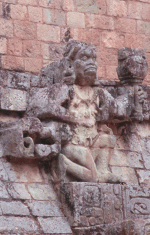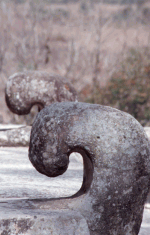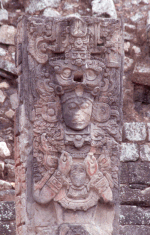written and photographed by Mary L. Peachin
Sep 2002, Vol. 6 No. 10
 The ruins of Copan are proud evidence that the dominance of Mayan culture extended into the Central American country of Honduras. Inhabited during the Classic Period (250 to 900 AD)or Golden Age of Mayan art and architecture, Copan covered 15-square miles and sustained a population of less than 30,000. By comparison, Guatemala’s Tikal ruins, better known to archeology lovers, spanned almost 70-square miles with a population of 70,000.
The ruins of Copan are proud evidence that the dominance of Mayan culture extended into the Central American country of Honduras. Inhabited during the Classic Period (250 to 900 AD)or Golden Age of Mayan art and architecture, Copan covered 15-square miles and sustained a population of less than 30,000. By comparison, Guatemala’s Tikal ruins, better known to archeology lovers, spanned almost 70-square miles with a population of 70,000.
 Lindblad Expeditions ship M.V. Sea Voyager, on its Caribbean Odyssey from Panama to Belize, docked in the port of Cortes. Disembarking, we explored the rainforest as we traveled for three-plus hours by bus along narrow roads enroute to the ruins. After spending several hours on a guided tour, we overnighted in the charming village of Copan Ruinas.
Lindblad Expeditions ship M.V. Sea Voyager, on its Caribbean Odyssey from Panama to Belize, docked in the port of Cortes. Disembarking, we explored the rainforest as we traveled for three-plus hours by bus along narrow roads enroute to the ruins. After spending several hours on a guided tour, we overnighted in the charming village of Copan Ruinas.
The archeology of Copan has been researched since the 1830s. To date, 4500 structures have been located in the small valley. Copan is most noted for the quality of its stelae (statutes or monolithic stone sculpture) and altars. Its primary attraction is a hieroglyphic stairway built with 1250 stone blocks containing 72 steps that were 50 feet wide and contained over 1,250 glyphs in 30,000 total pieces total. The stairway forms the longest written inscription in the Americas.
 Copan, ten miles south of the Guatemalan border, was built almost a 100 years after Tikal and thrived until 832 AD. Its 100-foot Acropolis was used for living, its Great Plaza served as the site for sacrificial rituals and ball games.
Copan, ten miles south of the Guatemalan border, was built almost a 100 years after Tikal and thrived until 832 AD. Its 100-foot Acropolis was used for living, its Great Plaza served as the site for sacrificial rituals and ball games.
Ricardo Agurcia Fasquelle continued his excavation under Temple 16 because he knew that Mayans were known to build temples on top of decaying structures. The result was the discovery of a well-preserved temple (dated to 571 AD), which he named Rosalila.
Among Agurcia discoveries were offerings that included incense burners and one fully intact jaguar-shaped vessel. Stingray spines, used for bleeding, and sacrificial knives were found along with fossils of shells that had been carried long distances from the beaches of the Pacific Ocean. Hieroglyphics featured symbols of birds like the Quetzal and Macaw.
 The demise of Copan was a result of disease and environmental destruction. The residents were unable to grow enough food for sustenance and they destroyed the surrounding forests forcing them to abandon Copan.
The demise of Copan was a result of disease and environmental destruction. The residents were unable to grow enough food for sustenance and they destroyed the surrounding forests forcing them to abandon Copan.
 At the peak of the Civilization, there were a total of 23 million Mayan people in Central America. There is evidence of an extensive trading system indicating they were good merchants on both land and sea. In this geographic area, now known as Mesoamerica, Mayans cultivated maize, beans, and cassava. Ruins have also been discovered in El Salvador, Guatemala and Belize, plus Mexico’s southern states of Chiapas, Tabasco, Campeche, the Yucatán, and Quintana Roo. Today, six million people living in the region are descendants of the Mayans.
At the peak of the Civilization, there were a total of 23 million Mayan people in Central America. There is evidence of an extensive trading system indicating they were good merchants on both land and sea. In this geographic area, now known as Mesoamerica, Mayans cultivated maize, beans, and cassava. Ruins have also been discovered in El Salvador, Guatemala and Belize, plus Mexico’s southern states of Chiapas, Tabasco, Campeche, the Yucatán, and Quintana Roo. Today, six million people living in the region are descendants of the Mayans.
Copan Ruinas
 Along the banks of the Copan River lies the charming village of Copan Ruinas. The focal point is a central plaza (Barrio Central) surrounded by cobblestone streets and white-stuccoed dwellings covered with red mission clay tile. Worshippers pray in a small cathedral at one end of the plaza, while at the other end, visitors view some of the artifacts of Copan displayed in a small anthropological museum.
Along the banks of the Copan River lies the charming village of Copan Ruinas. The focal point is a central plaza (Barrio Central) surrounded by cobblestone streets and white-stuccoed dwellings covered with red mission clay tile. Worshippers pray in a small cathedral at one end of the plaza, while at the other end, visitors view some of the artifacts of Copan displayed in a small anthropological museum.
 Approximately eighteen miles from the village is Beneficio de Cafe Santa Rosa coffee plantation and roasting plant. Coffee beans are harvested in late fall or early winter. If you are traveling by road to Copan from eastern Honduras, this is an interesting stop. Two pounds of coffee, which is not distributed on the market, can be purchased for $5.00.
Approximately eighteen miles from the village is Beneficio de Cafe Santa Rosa coffee plantation and roasting plant. Coffee beans are harvested in late fall or early winter. If you are traveling by road to Copan from eastern Honduras, this is an interesting stop. Two pounds of coffee, which is not distributed on the market, can be purchased for $5.00.
If you go:
Copan is a UNESCO World Heritage Site located about 100 miles from San Pedro Sula, and 300 miles from the capital city of Tegucigalpa.
For further information: go to www.copanmayafoundation.org or www.expeditions.com
Museo Regional de Antropolgía Entry fee is $2.00
The 40-room Hotel Marina Copán in Copán info@hotelmarinacopan.com. www.hotelmarinacopan.com.
